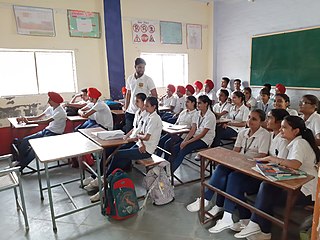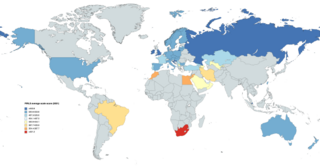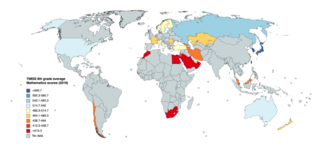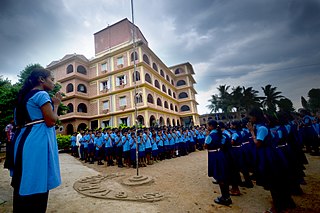Related Research Articles

In the United States, education is provided in public and private schools and by individuals through homeschooling. State governments set overall educational standards, often mandate standardized tests for K–12 public school systems and supervise, usually through a board of regents, state colleges, and universities. The bulk of the $1.3 trillion in funding comes from state and local governments, with federal funding accounting for about $260 billion in 2021 compared to around $200 billion in past years.

Education in India is primarily managed by the state-run public education system, which falls under the command of the government at three levels: central, state and local. Under various articles of the Indian Constitution and the Right of Children to Free and Compulsory Education Act, 2009, free and compulsory education is provided as a fundamental right to children aged 6 to 14. The approximate ratio of the total number of public schools to private schools in India is 10:3.
The National Center for Education Statistics (NCES) is the part of the United States Department of Education's Institute of Education Sciences (IES) that collects, analyzes, and publishes statistics on education and public school district finance information in the United States. It also conducts international comparisons of education statistics and provides leadership in developing and promoting the use of standardized terminology and definitions for the collection of those statistics. NCES is a principal agency of the U.S. Federal Statistical System.

The National Assessment of Educational Progress (NAEP) is the largest continuing and nationally representative assessment of what U.S. students know and can do in various subjects. NAEP is a congressionally mandated project administered by the National Center for Education Statistics (NCES), within the Institute of Education Sciences (IES) of the United States Department of Education. The first national administration of NAEP occurred in 1969. The National Assessment Governing Board (NAGB) is an independent, bipartisan board that sets policy for NAEP and is responsible for developing the framework and test specifications.The National Assessment Governing Board, whose members are appointed by the U.S. Secretary of Education, includes governors, state legislators, local and state school officials, educators, business representatives, and members of the general public. Congress created the 26-member Governing Board in 1988.

The IEA's Progress in International Reading Literacy Study (PIRLS) is an international study of reading (comprehension) achievement in 9-10 year olds. It has been conducted every five years since 2001 by the International Association for the Evaluation of Educational Achievement (IEA). It is designed to measure children's reading literacy achievement, to provide a baseline for future studies of trends in achievement, and to gather information about children's home and school experiences in learning to read.
Family literacy is a method of education. Relatively new, family literacy is being put into practice in the United States, Canada, and South Africa.

National Council of Educational Research and Training (NCERT) is an autonomous organisation of Ministry of Education, the Government of India. Established in 1961, it is a literary, scientific and charitable Society under the Societies Registration Act. Its headquarters are located at Sri Aurbindo Marg in New Delhi. Dr. Dinesh Prasad Saklani is the director of NCERT since 2022.

The International Association for the Evaluation of Educational Achievement (IEA)'s Trends in International Mathematics and Science Study (TIMSS) is a series of international assessments of the mathematics and science knowledge of students around the world. The participating students come from a diverse set of educational systems in terms of economic development, geographical location, and population size. In each of the participating educational systems, a minimum of 4,000 to 5,000 students is evaluated. Contextual data about the conditions in which participating students learn mathematics and science are collected from the students and their teachers, their principals, and their parents via questionnaires.

Jawahar Navodaya Vidyalaya (JNV) is a system of central schools for talented students predominantly from rural areas in India, targeting gifted students who lack access to accelerated learning due to financial, social and rural disadvantages.

Literacy in the United States was categorized by the National Center for Education Statistics into different literacy levels, with 92% of American adults having at least "Level 1" literacy in 2014. Nationally, over 20% of adult Americans have a literacy proficiency at or below Level 1. Adults in this range have difficulty using or understanding print materials. Those on the higher end of this category can perform simple tasks based on the information they read, but adults below Level 1 may only understand very basic vocabulary or be functionally illiterate. According to a 2020 report by Gallup based on data from the U.S. Department of Education, 54% of adults in the United States lack English literacy proficiency.

Reading is the process of taking in the sense or meaning of letters, symbols, etc., especially by sight or touch.
Kendriya Vidyalaya Malleswaram is a school in Bangalore, India. It is one of the schools under the group known as the Kendriya Vidyalayas, a system of central government schools under the Ministry of Human Resource Development (India). Kendriya Vidyalaya Malleshwaram is one of fourteen Kendriya Vidyalayas in Bangalore.
As per the 2011 census of India, Andhra Pradesh has an overall literacy rate of 67.35%, significantly lower than the overall national average of 74.04%. Among the Indian states and union territories, it stands at 32nd position. There were a total of 29,859,982 literates: 16,549,514 males and 13,310,468 females. In terms of district-wise literates, united East Godavari has the most with 3,348,077 and united Vizianagaram has the least with 1,238,388. The government also implements fee reimbursement scheme for the economically backward sections of the state.

The Ministry of Education (MoE) is a ministry of the Government of India, responsible for the implementation of the National Policy on Education. The ministry is further divided into two departments: the Department of School Education and Literacy, which deals with primary, secondary and higher secondary education, adult education and literacy, and the Department of Higher Education, which deals with university level education, technical education, scholarships, etc.

SWAYAM is an Indian government portal for a free open online course (MOOC) platform providing educational courses for university and college learners.

The NITI Aayog serves as the apex public policy think tank of the Government of India, and the nodal agency tasked with catalyzing economic development, and fostering cooperative federalism and moving away from bargaining federalism through the involvement of State Governments of India in the economic policy-making process using a bottom-up approach. Its initiatives include "15-year road map", "7-year vision, strategy, and action plan", AMRUT, Digital India, Atal Innovation Mission, Medical Education Reform, agriculture reforms, Indices Measuring States’ Performance in Health, Education and Water Management, Sub-Group of Chief Ministers on Rationalization of Centrally Sponsored Schemes, Sub-Group of Chief Ministers on Swachh Bharat Abhiyan, Sub-Group of Chief Ministers on Skill Development, Task Forces on Agriculture and up of Poverty, and Transforming India Lecture Series.

First Pinarayi Vijayan ministry is the Council of Ministers headed by Pinarayi Vijayan that was formed after the Left Democratic Front (LDF) won the 2016 Kerala Legislative Assembly elections. The Council assumed office on 25 May 2016. The ministry had a total of 19 ministers in the Cabinet at the time of swearing-in compared to 21 ministers in the previous government. Pinarayi Vijayan sworn in as 22nd Chief Minister of Kerala, 12th person to hold this position. Chief Minister Pinarayi Vijayan on 3 May 2021 submitted the resignation of the Council of Ministers headed by him to Governor Arif Mohammed Khan after winning a historic victory in the 15th legislative assembly elections by winning 99 of the 140 seats in the Assembly.

Gram Vikas Residential School is a co-educational Odia medium school that offers education from Grade 3 to Grade 10 level in Odisha, India. The school was founded in 1982 by Dr. Joe Madiath. It is affiliated to the Board of Secondary Education, Odisha. It has four branches. Gram Vikas High School was established in 1982 at Kankia village in the Ganjam district. Mahendra Tanaya Ashram School was established in Koinpur village in Gajapati District of Odisha in 1992. Two more schools, Gram Vikas Shiksa Niketan and Gram Vikas Vidya Vihar, were established in 1998 and 2002 in Kalahandi district and Ganjam district, respectively.
The National Education Policy of India 2020, which was started by the Union Cabinet of India on 29 July 2020, outlines the vision of new education system of India. The new policy replaces the previous National Policy on Education, 1986. The policy is a comprehensive framework for elementary education to higher as well as vocational training in both rural and urban India. The policy aims to transform India's education system by 2030.

In 2020, school systems in the United States began to close down in March because of the spread of COVID-19. This was a historic event in the history of the United States schooling system because it forced schools to shut-down. At the very peak of school closures, COVID-19 affected 55.1 million students in 124,000 public and private U.S. schools. The effects of widespread school shut-downs were felt nationwide, and aggravated several social inequalities in gender, technology, educational achievement, and mental health.
References
- ↑ "NAS program". nas.gov.in. Retrieved 2024-07-26.
- ↑ "Aims and objectives of NAS" (PDF). Department of School Education and Literacy. 2022-03-23. Retrieved 2024-06-02.
- ↑ "Learnings for Large–scale Transformation in School Education" (PDF). NITI Aayog . Retrieved 2024-07-26.
- ↑ "National Steering Committee". nas.education.gov.in. Retrieved 2024-07-26.
- ↑ Learning about the Learning Outcomes: Evidencing the Student Performance (PDF) (1st ed.). India: NCERT. 2024. ISBN 978-93-5292-839-2.
- ↑ "Project SATH-E | NITI Aayog". www.niti.gov.in. Retrieved 2024-06-02.
- ↑ "Learnings for Large–scale Transformation in School Education" (PDF). NITI Aayog. Retrieved 2024-06-02.
- ↑ "National Achievement Survey conducted successfully with 96% schools' participation from 24 states". The Indian Express. 2021-11-13. Retrieved 2024-06-02.
- ↑ "National Achievement Survey- State Reports". ncert.nic.in. Retrieved 2024-07-26.
- ↑ "NAS-17 Report Card". nas.gov.in. Retrieved 2024-07-26.
- ↑ "Undoing learning loss from Covid most urgent". The Indian Express. 2024-07-23. Retrieved 2024-07-26.
- ↑ Banerjee, Shilpi; Aanchal, Chomal (2022-07-08). "India's dipping learning levels". Deccan Herald . Retrieved 2024-07-26.
- ↑ "About NAS". nas.gov.in. Retrieved 2024-04-28.
- ↑ "National Achievement Survey | Ministry of Education, GoI". dsel.education.gov.in. Retrieved 2024-07-26.
- ↑ "NAS 2021 Report card". nas.gov.in. Retrieved 2024-07-26.